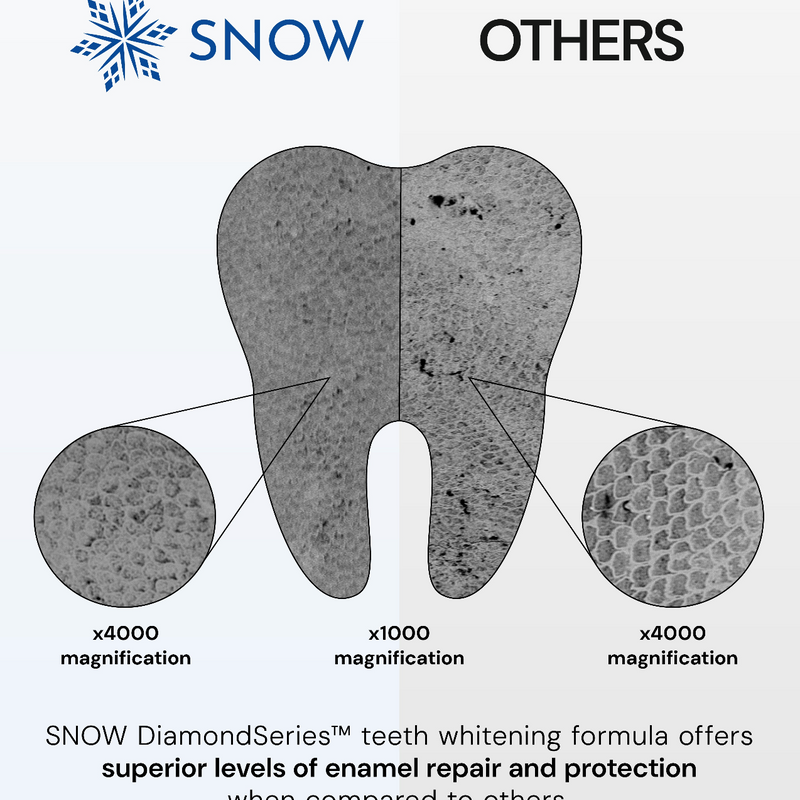Part of having a bright dazzling smile is having healthy gums too.
Picture this scenario, you're performing your daily oral hygiene routine and after brushing and flossing you notice that not only are you bleeding, but your gums are swollen, red, and irritated.
If you're experiencing swollen gums and bleeding after brushing, chances are you may have gingivitis, also known as gum disease. This is one of the first signs.
Gingivitis is fairly common and if caught early it may be reversible. According to the National Institute of Dental and Craniofacial Research, gum disease affects nearly 50% of adults aged 30 and older and affects 70% of adults aged 65 and older.
The CDC reports that gum disease is more prevalent in men than women, those with low income living below the federal poverty level, those with below high school level education, and regular smokers and tobacco users.
Gum disease and tooth decay are two of the larger threats to dental health.
WHAT IS GINGIVITIS?
Gingivitis, is a mild form of gum disease that causes redness, irritation, and swelling of the gum line. Gingivitis occurs when dental plaque (the sticky slimy film you feel over your teeth) builds up and bacteria eventually causes infection of the gum tissue. This process often results in gum inflammation, recession, and irritation.
WHAT IS PERIODONTAL DISEASE?
Periodontal disease is a more advanced form of gum disease. Severe gum disease may result in loose teeth, gum recession, and even tooth loss. You may even need surgery to course correct this when it comes to more severe cases.
IS GINGIVITIS REVERSIBLE?
In many cases, yes. Gingivitis may be reversible if it is caught early and action is taken immediately. According to the American Dental Association, if you've been diagnosed with gum disease the good news is it can often be treated successfully. Ideally, you shouldn't have to lose teeth to periodontal diseases.
However, if gingivitis is left untreated, it may lead to a more serious periodontal disease called periodontitis.
CAUSES OF GINGIVITIS
The most common reason for gingivitis is poor oral hygiene. A good oral hygiene routine involves daily brushing and flossing as well as regular dental checkups where a dental hygienist professionally removes plaque and tartar buildup.
When bacteria stay on the teeth for too long it turns into plaque, plaque forms, and then hardens into tartar, which then reaches the gum tissue resulting in gingivitis.
To fully remove stubborn tartar, a dental professional must be consulted in order to treat periodontal diseases and restore the health of your teeth and gums.
COMMON CAUSES AND RISK FACTORS:
- Poor oral hygiene
- Plaque and tartar buildup
- Poor nutrition
- Certain medications (i.e. oral contraceptives, calcium channel blockers, phenytoin, etc.)
- Chronic diseases
- Diabetes
- Systemic diseases
- Not visiting a dentist regularly
- Stress
- Hormonal changes
- Family history / genetics
- Pregnancy
- Smoking and tobacco usage
- Weak immune system
SYMPTOMS
Gingivitis isn't always painful so you may not even feel that you have it. If you suspect that you may be developing gingivitis, there are certain signs and symptoms to look for when it comes to gum disease.
If you notice any of the following, it's a good idea to get a full dental exam to be sure if you indeed have gingivitis.
COMMON SYMPTOMS OF EARLY GINGIVITIS:
BAD BREATH
Halitosis (also known as bad breath) that will not go away no matter how many times you brush your teeth or rinse with an antiseptic mouthwash. Plaque buildup in your mouth creates the perfect home for millions of bacteria. This bacteria is what causes your breath to smell foul.
BLEEDING GUMS
Gums that bleed after brushing and flossing. This is one of the early indicators of gum disease. This is also commonly how your dentist can quickly tell if you haven't been flossing regularly.
PUFFY GUMS
Swollen, puffy, and inflamed gums could be an early form of gingivitis. Gingival inflammation is one of the first mild symptoms of gum disease. When tartar builds up it starts to irritate the 'gingiva' also known as the gum area arching around the teeth.
SORE AND TENDER GUMS
Sore gums that are achy and tender to the touch or when you're eating and drinking.
REDNESS OR GUM IRRITATION
Healthy gums should be pale pink and even in color. Extreme redness and irritation could be a sign of gum infection.
COMMON SYMPTOMS OF PERIODONTAL DISEASE:
Periodontal disease is a more advanced form of gum disease, beyond the stage of gingivitis. If you're experiencing any of the symptoms below, seek guidance and treatment from your dentist immediately.
RECEDING GUMS
A gum line that is getting smaller may be a sign of gingivitis. Smaller gums and bigger teeth is often caused by gum recession.
LOOSE TEETH
Teeth that wiggle to the touch or feel less firm in your mouth. Advanced gum disease deteriorates the bone around the top of your teeth which may cause some looseness.
SHIFTING OR CROOKED TEETH
Changes in your bite or the way your teeth fit in your mouth. If you wear retainers or aligners that are no longer fitting properly that could also be a sign of teeth shifting.
TOOTH LOSS
Losing teeth may be an advanced sign of gum disease.
SENSITIVE TEETH
Gum recession exposes the teeth and may cause them to feel more sensitive. If you notice a receding gum line and newfound sensitivity to hot and cold foods, this could also be a sign of gum disease.
TREATMENT OF PERIODONTAL DISEASE
In more severe cases of periodontal disease, you may need surgery performed by a periodontist. Severe cases of gum disease occur when the level of gum and bone tissue loss is advanced. Common surgeries are flap surgery, bone and soft tissue grafts, and dental crown lengthening.
WAYS TO TREAT AND PREVENT GINGIVITIS
There are many ways to treat and prevent gingivitis. A mix of lifestyle changes and professional treatment can get you back on the right track. Here are a few ways to get gingivitis under control.
TREATMENT
HAVE A PROFESSIONAL DEEP CLEAN YOUR TEETH AND GUMS
To prevent gum disease and treat gingivitis you'll need to have a dental professional remove plaque and tartar from your teeth. Having your teeth regularly cleaned is key to preventing gingivitis.
A dental hygienist may use techniques such as scaling and root planing as well as lasers to thoroughly remove plaque/tartar buildup that has accumulated on your teeth. They'll also clean underneath the gum line thoroughly.
MEDICATION
Depending on how severe your case of gum disease is, your dentist may recommend over-the-counter medications for pain or infection. There are a variety of medications you can take such as anti-bacterial mouthwash, NSAIDs, oral antibiotics, and doxycycline.
PREVENTION
VISIT THE DENTIST REGULARLY
Ensure you're getting your routine dental cleanings. Some people build up tartar and plaque more easily than others. It's important to keep up with your dental health to avoid any form of gum disease. Most health care providers offer dental plans that include dental checkups as well as routine deep cleanings.
PRACTICE GOOD ORAL HYGIENE
You'll need to be diligent about practicing good oral hygiene and ensuring your teeth and gums are free of bacterial infection. Poor oral hygiene can negatively affect oral health as well as cause future health conditions.
The American Dental Association recommends that you brush your teeth two times a day with a soft-bristled brush and also use ADA-approved toothpaste. Brush for two minutes two times a day. Make sure to replace your toothbrush every three to four months or once the bristles have become frayed.
And, of course, clean between your teeth every day to get rid of any lingering food particles.
The best way to fight infection is to level up your oral hygiene routine by doing the following:
- Brush your teeth regularly and after every meal
- Floss every single day
- Rinse with an antibacterial mouthwash
- Use anti-gingivitis specific products
CHECK YOUR GUM TISSUE REGULARLY
Keep an eye on the health of your gums. If you notice any changes in color, extreme redness, or abnormal texture make an appointment to visit your dentist. Your gums should be tight around your teeth and even pale pink in color.
CHANGE YOUR LIFESTYLE HABITS
If there are risk factors within your control, it's time to take charge in order to avoid gingivitis.
Below are common lifestyle choices that may be causing gingivitis.
Smoking or using tobacco
Smoking weakens your body's ability to fight infection. You're at higher risk of getting gingivitis since your immune system isn't in the best shape to prevent or heal gum disease. If you're a smoker, you have twice the risk of getting gum disease in comparison to a nonsmoker. It's best to cease all smoking and tobacco usage entirely.
High stress levels
Stress wreaks havoc on so many aspects of your life. Avoid living in 'fight or flight mode' or in prolonged periods of stress. It's difficult for the body to heal itself when it's under constant stress.
Not eating a healthy diet
Eat a balanced nutritious diet that is free of sugary junk food or highly processed food that are abrasive to your teeth. Taking control of your health will help you fight infection and prevent gingivitis.
Frequently Asked Questions
How do you fix gingivitis?
To help eliminate plaque use mouthwash. Brushing and flossing should be supplemented with an interdental cleaner, such as a dental pick, interdental brush, or other dental stick developed specifically to clean between teeth. Schedule frequent professional dental cleanings according to your dentist's recommendations.
Does gingivitis go away?
Gingivitis is the first stage of gum disease and can be treated with improved dental hygiene. It's also critical to schedule regular dental cleanings to eliminate plaque and tartar accumulation.
Is gingivitis reversible?
Gingivitis may be avoided and treated with basic oral care and a little help from your dentist and dental hygienist.
How long does it take to get rid of gingivitis?
For people with gingivitis due to poor dental hygiene, the average time it takes to improve is 10 to 14 days following adequate oral healthcare.
Can gingivitis go away on its own?
It can potentially go away on its own with proper care and if it's caught early. However, if steps are not taken to improve oral health care, gingivitis will not go away.
WHEN TO SEE A DENTIST
If you're experiencing symptoms of gingivitis, make a dental appointment as soon as possible to have your teeth and gums professionally examined. You may be in deep need of professional cleaning in order to improve your oral health.
There's nothing to be ashamed of and it's normal to feel anxiety if you're worried you have gum disease. A great dentist will help you get back on track.


























